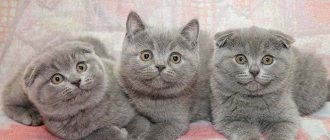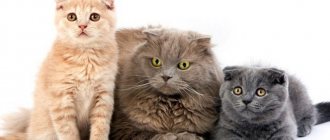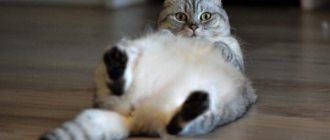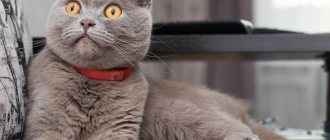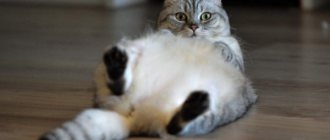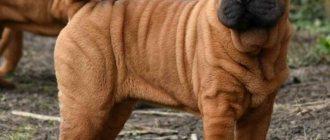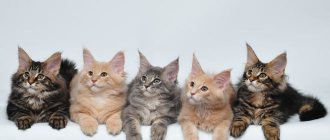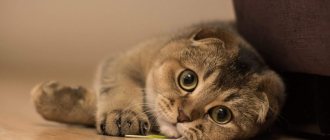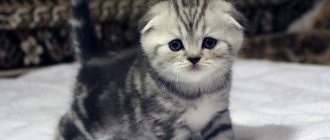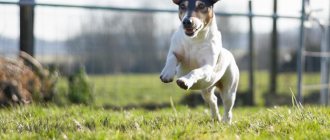Scottish cats have different colors. Scottish cats are famous because of their charming appearance and variety of colors. The color of kittens directly depends on certain genes. As a rule, these are two main shades, black and white.
Scottish Straight colors, for example, are gray with black stripes around the entire body. They are distributed as a percentage. That is, the animal’s fur is painted in two colors in different proportions. Its own gene is responsible for the dominance of one color or another.
Plain (solid)
The color of Scottish Fold cats is monochromatic and they should not have any other color. The fold-eared cat can be of the following colors: white and black, chocolate and lilac, blue and red, cream, fawn and cinnamon. The most popular color in the world among solid Scottish cats is blue. These are the majority of cats.
White
The white Scottish Straight cat can have different eyes, from blue and bright orange to rich amber and copper. Kittens of this variety remain white for the rest of their lives. If kittens have spots, then an adult cat remains white for the rest of its life.
Black
The Scottish Fold black cat is mostly bright in color. A couple of white hairs are acceptable, but if the cat has large red and brown patches, then it is not a purebred.
Black Scottish Fold cats should be bright black in color and their ears, like all fold-eared cats, should be pressed to the head, unlike straight-eared cats. A straight-eared black cat always has its ears erect.
Chocolate
The chocolate Scottish Fold looks impressive. The chocolate color is quite rare. Brown fold kittens should have a smooth, uniform coat of chocolate color. The dark brown coloring adds nobility to the cat.
A brown cat gets this color if he has chocolate, chocolate bicolor or chocolate color points in his pedigree. Chocolate Scottish kittens always delight their owners. They look very cool against a light background.
Lilac (lavender)
A lilac long-eared cat gets this color if he has either lilac color points or lilac in his pedigree. The lilac coloration goes well with orange, copper or amber colored eyes and a light brown nose. This color is also called coffee with milk.
Blue color (blue)
The Scots Blue can have a coat color of many shades of blue. Some cats may have a fur color closer to gray, and some closer to blue. Each hair must be saturated, then the coat will be perfectly blue.
Scottish Fold color codes
The concept of color is represented by the color of the cat's fur, the pattern of stripes or its complete absence, the presence or absence of white spots on the fur . Also degrees of coloration. The basic colors are red and black.
This is interesting! Currently, for the purpose of unification, an absolutely clear coding system has been developed, which is used by FIFе and WСF specialists.
This system is very convenient, and includes not only alphabetic, but also digital designations:
- a - bluе or light blue color;
- b - chocolate, brown and chestnut or chocolate, brown coloring, as well as Havana and champagne;
- c - lilac, lavender or lilac and lavender, as well as platinum color;
- d - red, flame or red color;
- e - cream or cream color;
- f - tortoiseshell and patch or tortoiseshell color;
- g - blue-cream and blue-tortie or bluish-cream, bluish-tortoiseshell color;
- h - chocolate-tortie or chocolate tortoiseshell color;
- j - lilac-toortie or lilac-tortoiseshell color;
- n - black, ebony, seal, sable and ruddy or black, ebony and seal colors, as well as sable and wild colors;
- o - sorrel, cinnamon and honey or sorrel and cinnamon, as well as honey color;
- p - beige fawn or yellow-brown and beige color;
- q - sorrel tortie or red-brown, tortoiseshell color;
- r - beige fawn tortie or beige tortoiseshell color;
- s - silver and smoke or silver and smoky color;
- w - white or white color;
- x - unregistered or color of an unregistered type;
- y - golden or golden color.
Registered digital designation of the coat color of the Scottish Fold breed:
- 01 - van or “van”;
- 02 - harlequin or “harlequin”;
- 03 - bicolour or “two-color”, “bicolor”;
- 04 - mitted/white point or color point with white markings;
- 09 - little white spots or with white spots measuring 1-2 cm;
- 11 - shaded or with the upper part of the coat darkened by a quarter;
- 12 - tippred, shell or with darkening of the upper part of the coat 1/8 from the tip;
- 21 - tabby, agouti or with stripes, “agouti factor”;
- 22 - blotched, marble or “marble”;
- 23 - mackerel, tiger or “mackerel” and “tiger”;
- 24 - spotted or “spotted”
- 25 – ticked or ticked “Abyssinian”.
Thanks to convenient classification and coding, it is possible to select an animal with the most incredible coat color.
Return to content
Bicolors
The coat color of these beautiful creatures has two colors, and a combination of white and any other shade is mandatory. Purebred bicolors must have a white belly, neck, chest, chin, limbs and, of course, muzzle.
Particolor (calico)
A Scottish cat of this type, called particolor, is a combination of white with tortoiseshell or spotted tabby color.
Harlequin
Harlequin captivated everyone with his unusual appearance. The cat is painted white (4/5 parts of the body), but the tail must be black, as well as the ears and the top of the head. The ventral part is white. The tip of the nose, like most people, is the same color – pink.
Wang
This breed only has colored tail, and sometimes has a few spots on the head. It happens that there are solid spots on the paws and back, but this is considered undesirable. When this breed develops red spots, it may also be called a Red Van.
Solid
This coat coloring is also called plain, solid. The main feature is that the coat is uniformly colored in one color, without even the slightest inclusions of a different tone. The color is equally saturated along the entire length of the hair.
Solid suits of the “Scots”:
- blue (gray-silver);
- ebony (all black);
- red (red);
- white;
- cream;
- chocolate (rich brown color);
- cinnamon (cinnamon tones);
- lilac (beige with a lilac, pinkish tint);
- “fauns” (beige, piebald).
The most classic color for Scottish cats is blue.
Photos of Scottish cats of solid colors:
Color point
The Color Point is a rare breed of Scottish cat with a color similar to that of a Siamese cat. In childhood they look a little like Thai kittens. The main background is white or cream. The muzzle, ears, paws and tail are painted in darker shades. Color point or links point have blue eyes.
They acquired their colors from their British ancestors, who had Persians with this shade in their family. By the way, it is very difficult to distinguish a British cat from a Scottish one, and even professionals cannot always do this.
Comparison with British cats
The Scottish Fold is not a British Shorthair breed. At the beginning of its history, the individual was mated with a Briton, which is why the kittens received external characteristics from the British and became similar to them: this is the color of the coat, its length and shape, eye color, and the size of the animal’s body. The exterior of the British cat differs from the Scots cat, although the British cat is just as large, the chin and cheeks of the animal are well defined. The difference in the two breeds can also be replaced in the structure of the paws. The Scots have them more graceful, thin, and long.
The easiest way to determine what kind of breed is in front of you is to look at the animal's ears. But keep in mind that Scots with straight ears are also almost no different from the British. All British cat kittens are born with erect ears. Scottish Straights are a Scottish breed because only a fold-eared cat can produce them in a litter. In fact, erect ears can be partly considered unique to this breed.
Pets are also distinguishable by their personalities. The British Shorthair breed is very aristocratic and arrogant; there may be some coldness towards its owners. She does not tolerate affection or squeezing. All these affections happen only with her permission, whenever she wants. The Scots, on the contrary, are extremely loving animals and are always happy to be stroked, play, and have various events.
Fold cats are not very active vocally, but they talk to their owner by purring. If you put two breeds of the same color next to each other and start talking and playing with them, it will immediately become clear which one is which.
Tabby (tabby)
Tabby is one of the most popular cats among Scots. The color of Scottish tabby cats is distinguished by the presence of a pattern in a certain area on the coat. The pattern on the wool can be anything. A distinctive feature is considered to be a pattern in the form of the letter M on the forehead.
Tabby color depending on the type of pattern:
- striped like a tiger (has vertical stripes on the sides);
- spotted;
- marble (pattern of chaotic spots and stripes of different sizes).
And depending on the color combinations to the following:
- golden tabbies;
- cream tabby;
- blue;
- black marble;
- marble on silver
- silvery blue (gray tint);
- silver (silver color);
- cameo.
Features of care
If you do manage to become the happy owner of a snow-white, blue-eyed miracle, you need to provide your pet with comfortable living conditions.
It is best to place a house for a kitten in a secluded place, protected from drafts, to which kittens are very sensitive. It is necessary to regularly examine the animal's eyes and nose, as watery eyes can be a sign of a cold. There is also a very high risk of developing bronchitis.
Scottish Folds quickly get accustomed to the tray, but for white animals its height must be chosen higher to avoid contamination of the paws and belly.
Snow-white wool will require more frequent bathing (for other colors, bathing is necessary once every 2 months), and detergents should be soft and neutral, without coloring ingredients and fragrances
After washing, wet wool should be carefully blotted with a towel and dried with a hairdryer to prevent dust from sticking.
A kitten needs a complete diet, rich in vitamins and microelements, which can contain natural food (lean meats, fish, boiled vegetables, cereals, dairy products) or premium food. If necessary, you can include various dietary supplements in your diet.
For information on the features of caring for cats of this breed, see the following video.
Chinchilla
Another variation of the tipped color: only a certain part of the hair is colored, and the base is white. If smoky cats have ⅔ colored hairs, then chinchillas have only ⅛ colored hairs. Because of such an unusual coloring, it seems that the white Scottish Fold has an unusual color coating. The chinchilla color comes in variations:
- golden;
- silver;
- blue golden.
The last type is the rarest, which is why its owners are the most expensive.
"Scots" chinchilla colors:
Scottish content
Speaking of content, it should be mentioned that the Scottish breed is characterized by a number of genetic diseases. Therefore, this cute kitty should be examined regularly by a veterinarian.
Caring for a cat does not bother owners: the coat is combed once a week for short-haired subspecies, and 2 times for long-haired subspecies.
The ears need regular inspection and weekly cleaning with a clean, damp cotton swab.
To keep cats healthy and maintain muscle tone, it is necessary to walk them and play outdoor games with them.
Upbringing
global $ads_google;
//data-ad-slot=”2475549904″ $ads_google = empty($ads_google) ? false : true; ?> if ($ads_google == false) {?> $ads_google = true; ?> } ?> There is a myth about the magical breeding of the Scottish breed. If you do not raise a Scottish cat from childhood, then there can be no talk of any kind of good manners.
In general, we can say that intelligence makes it easy to accustom a cat to a litter box, a scratching post, and decent behavior in public places.
It is unlikely that the plate will fall off the table on purpose - vindictiveness is not in the nature of the Scottish cat. But the question of what the well-mannered pussy was doing on the kitchen table is already addressed to the owner.
All subspecies of Scots are perfectly amenable to educational processes, but this needs to start from childhood.
Bathing
Scottish cats are not bathed often, mainly if the cat is obviously dirty, or before visiting an exhibition.
It is enough to wash the animal’s paws with water if they are very dirty, and once every six months give the cat a full bath. Wash your pet with products intended only for cats.
Many people switch to dry shampoos, which do an excellent job of removing dirt and do not create stress for the animal from contact with water.
Feeding
The owner can choose from several types of food for the furry pet: natural products, dry food or jelly food.
Natural food is always preferable: the owner should worry about the quality and shelf life of the food product. But ready-made food will be better balanced in terms of vitamins and various elements.
In any case, the cat will benefit from beef, chicken breast, boiled liver once a week, low-fat kefir, cottage cheese and boiled yolk. You should not overdo it with fish, it can lead to kidney diseases.
It is useful to include cereals in the menu that fill your pet with energy.
Kitten care
A Scotsman kitten does not require special care.
It can be fed with excellent quality dry food, and it is not necessary to subject it to brushing for no apparent reason. Of course, kittens with long hair will have to be gradually accustomed to brushing, but this should not be done too often. To begin with, it is enough to comb the baby once every 12-15 days.
There is no need to bathe babies unless they get really dirty.
Since childhood, children have their nails cut once a week.
The ears usually do not need cleaning, but if there is an unpleasant odor coming from them, contact a veterinarian.
The eyes are washed with a cotton swab soaked in water with chlorhexidine once a week if they begin to water.
Health of the Scottish cat breed
global $ads_google;
//data-ad-slot=”2475549904″ $ads_google = empty($ads_google) ? false : true; ?> if ($ads_google == false) {?> $ads_google = true; ?> } ?> With the health of the Scottish cat , not everything is smooth along the genetic line.
The ear mutation is associated with abnormal development of the skeletal system. Possible bone deformations, hardening of the tail, and difficulty moving. In defense of the breed, we can say that this is often the fault of unscrupulous breeders who cross Fold with Fold.
Hypertrophic cardiomyopathy (heart pathology) is also common in the Scottish cat, but this disease also affects other cat breeds.
The list of diseases includes polycystic kidney disease.
Modern veterinary medicine can help cats in many cases, but it is better to initially take a healthy kitten and take care of its health from childhood.
Scottish physical activity
The Scots can lead a fairly sedate lifestyle, living in the confined space of a house or apartment.
If the animal does not have access to an open street area, the owner must purchase all kinds of accessories for the animal - cat exercise equipment, houses, scratching posts, etc. If you do not provide the animal with the opportunity to stimulate physical activity, the cat will not only get bored, but also gain excess weight. It is also important to know what to feed your Scottish Straight cat to prevent obesity and create an optimal healthy diet.
Top 10 original nicknames
- Ushastik (cartoon);
- Whiskas (advertising);
- Masyanya (Internet character);
- Nafanya (cartoon “Little Brownie Kuzya”);
- Hedwig (Harry Potter's owl);
- Seal (animal);
- Teddy (teddy bear);
- Velours;
- Cloud (cloud – cloud, English);
- Bun.
Well, the name for the Scottish cat has been chosen. Congratulations! Let's move on to task number two: what to feed and love for kittens. Until the end of the cat's days. May they be long and full of celebration!
By the way, if you are familiar with the breed, then here’s how to name a British cat or a British cat, or if you want to name it based on a large list - read articles about all the names for cats.
Tortoiseshells
The English name for the color is torti. On the fur of the “turtles” dark spots are intricately combined with light ones. The variegated coloring must be distributed evenly over the body, which distinguishes torties from tricolor cats.
In Scottish Folds, the “tortoise” pattern occurs in variations:
- black-red;
- creamy lilac;
- chocolate red;
- creamy blue.
Interestingly, only cats can be “turtles”. In cats, this is a genetic mutation indicating infertility.
Scottish fold tortie color:
Harlequin
The name was given because the owner of the color is similar to a harlequin. The main color of the coat is white. And only ⅕-⅙ of the body area are colored spots. They are not concentrated in one area, but can be scattered throughout the body.
Photos of harlequin cats:
Shaded
Shedded (shaded color) is the third variation of typing colors. These cats have ⅔ white hair and ⅓ colored hair. Tipped fur does not cover the entire body, but only the back, sides, back of the head, neck, and tail. White coat - on the belly, chin, and lower part of the tail.
Shedded is represented by coloring pages:
Photo of “Scots” of shaded color:
